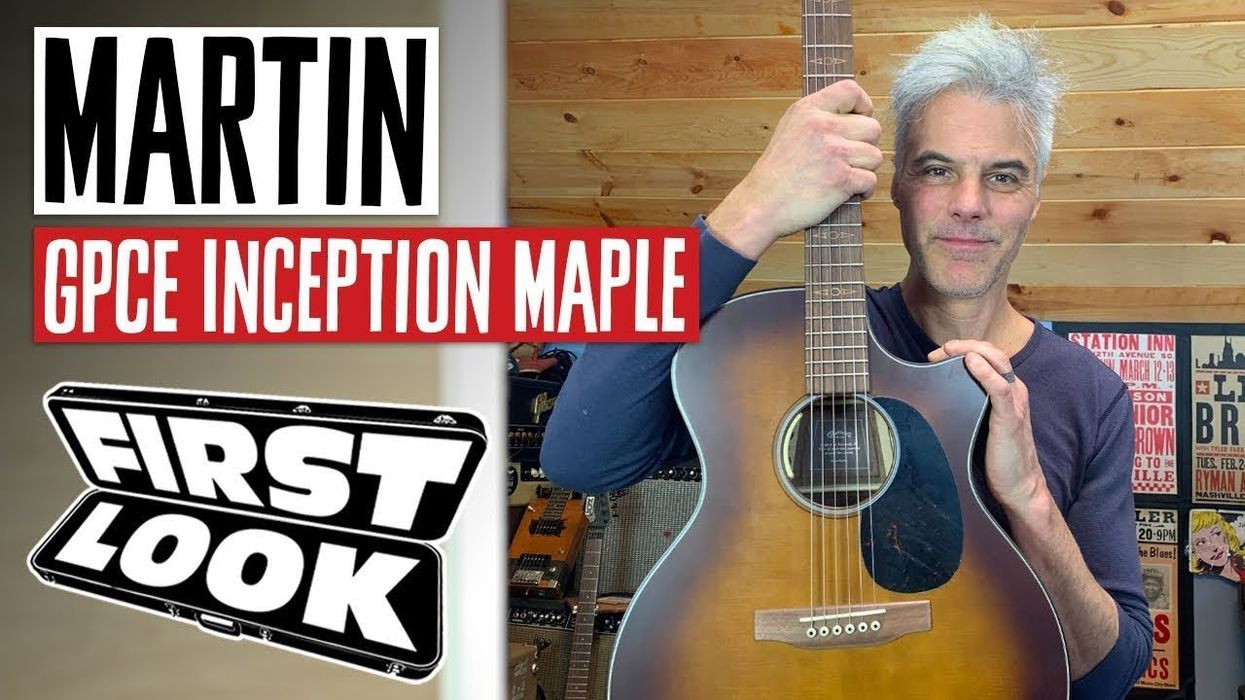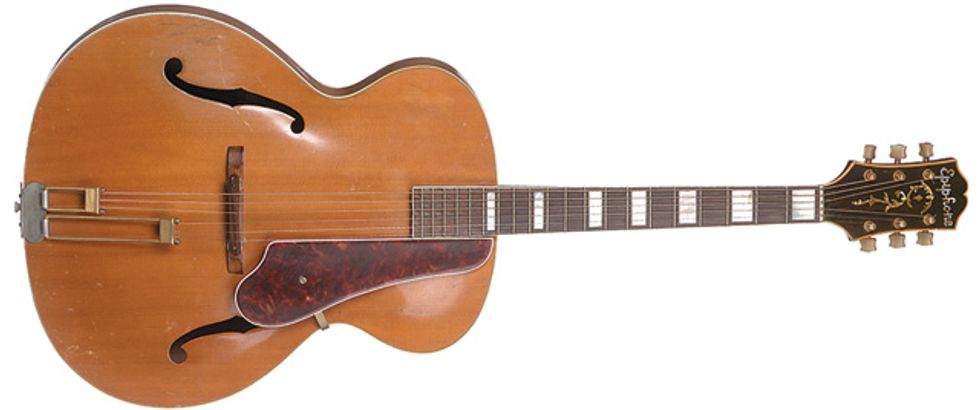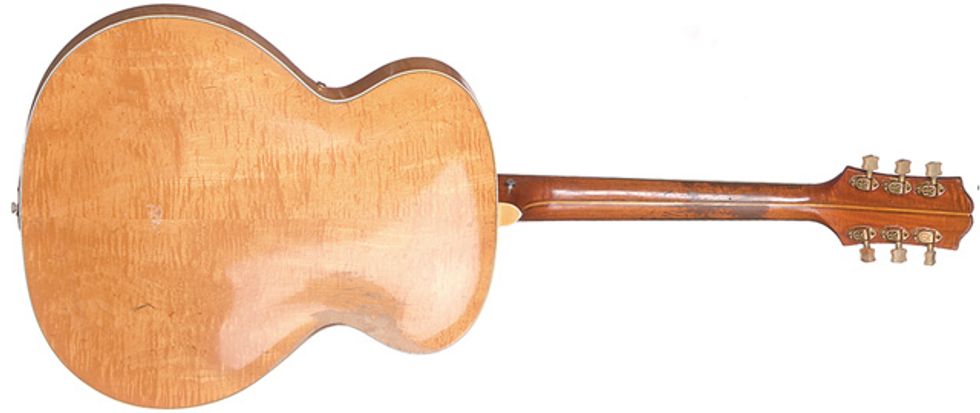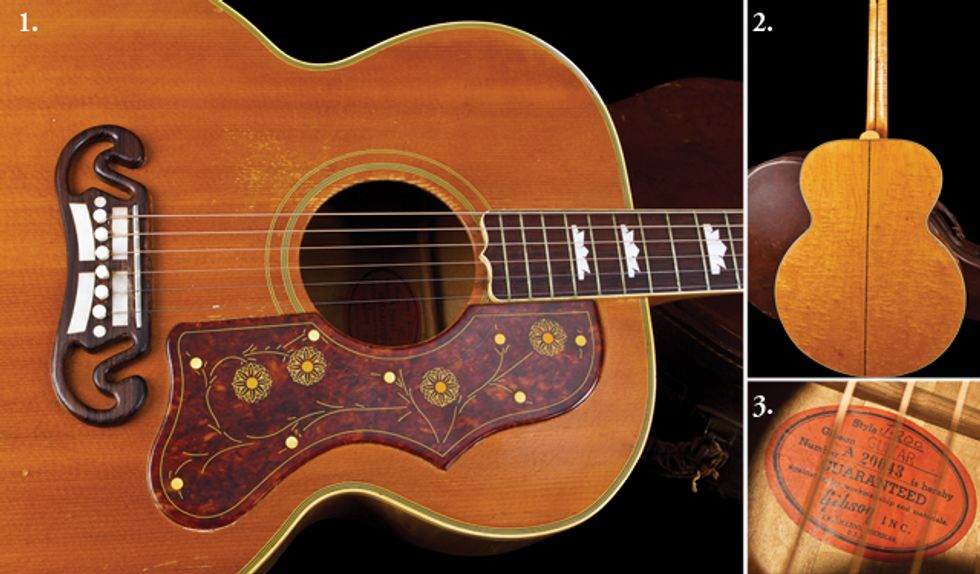Skeletonized scalloped bracing makes this most untraditional Martin flattop light and extra resonant.
A 1951 Epiphone Broadway in mostly original condition. Manufactured until 1957, the Broadway is considered “third-best” in the Masterbilt series of archtops. Hey Zach, I noticed you haven’t discussed
A 1951 Epiphone Broadway in
mostly original condition. Manufactured
until 1957, the Broadway is considered
“third-best” in the Masterbilt series
of archtops.
Hey Zach,
I noticed you haven’t discussed any
Epiphone archtops in your column
before, and I think most readers would
agree that Epiphone made some great
archtops prior to getting bought by
Gibson. I have an Epiphone Broadway
with a serial number 610XX. It’s all
original, except for the strap button
and the neck binding, but it does have
some missing finish on the back and
neck. Can you tell me a little about
this guitar and what it’s worth today?
Thanks,
Cam in Salem, Oregon
With a 17 3/8"
wide body, these large Epiphones are
considered to be some of the best
production-model archtops ever built.
Hi Cam,
You’re right. I haven’t covered an Epiphone
archtop before, so I’m glad you wrote! As
you probably know, Epiphone’s roots go
back to 1873, when Anastasios Stathopoulo
began building instruments in Greece. The
family moved to New York in 1903, and
when “The House of Stathopoulo” was
incorporated in 1923, they immediately
announced that “the new policy of business
and all interest will be devoted to the
production of banjos, tenor banjos, banjo
mandolins, banjo guitars, and banjo ukuleles
under the registered trademark name
of ‘Epiphone.’” The instruments from their
elegant Recording line of tenor banjos are
considered to be among the finest ever
made. And they were joined in the late
1920s by a full line of Recording series
guitars. In 1928, the company’s name was
changed to The Epiphone Banjo Company.
The Masterbilt series of guitars was introduced in 1931, marking Epiphone’s entrance into the production of carved archtop guitars—based on violin construction principles. At the time of their introduction, the instruments in the Masterbilt series represented the most complete selection of f-hole guitars available from any instrument maker in the world (including Gibson). By 1935, the company was simply known as “Epiphone, Inc.,” and has primarily been a guitar manufacturer ever since.
The Broadway was one of the original guitars in the Masterbilt series. And in terms of appointments, it is generally considered to be the “third-best” Epiphone archtop, behind the top-of-the-line Emperor (introduced in 1935) and the De Luxe. That said, the short-lived Tudor (produced between 1933 and 1936) is also considered to be a higher-level instrument than the Broadway.
Based on the serial number, your guitar is a later version of the Broadway that was produced in 1951. Features of your guitar include a spruce top, curly maple back and sides, a 3-piece maple/mahogany neck, a 20-fret bound-rosewood fretboard, and pearl-block inlays. Other features include the bound headstock with a “center dip” and single flower inlay, a bound-tortoiseshell pickguard, a rosewood-based bridge, and the famous Frequensator tailpiece.
Like many guitars from this era, the Broadway went through a number of changes over the years. It started out with a 16 3/8"-wide body, but was widened substantially to 17 3/8" by 1936. The biggest change was in 1939, the year Epiphone switched from American walnut to curly maple for the back and sides. It should be noted that 1951 was the first year for the single flower inlay on the headstock, which replaced the vine design. The new (and less radical) f-holes were introduced in 1951 as well, and the Broadway remained in Epiphone’s product line through 1957 when Gibson bought the company. Though this marked the end of production for the acoustic Broadway, Gibson actually produced an electric version until 1970, the year all Epiphone production moved overseas.
Your Broadway has a decent amount of wear from what appears to be normal playing. But it is mostly in all original condition, which is very important. The binding probably dried up and cracked on the neck, which is why it had to be replaced. And chances are the strap button simply broke. With everything else intact including the tuners, pickguard, and bridge, this is a good example of a mostly original-condition guitar with slight wear. Based on the overall condition and original equipment still remaining, it is currently valued between $2,000 and $2,500.
Many collectors consider the large-body Epiphones manufactured between 1937 and 1957 to be some of the best factorybuilt archtops ever produced. And you simply don’t find many of them in this original condition. This is definitely a treasure you’ll want to hold on to!
 Zachary R. Fjestad
is author of Blue Book of
Acoustic Guitars, Blue Book
of Electric Guitars, and Blue
Book of Guitar Amplifiers.
For more information, visit
bluebookinc.com or email
Zach at guitars@bluebookinc.com.
Zachary R. Fjestad
is author of Blue Book of
Acoustic Guitars, Blue Book
of Electric Guitars, and Blue
Book of Guitar Amplifiers.
For more information, visit
bluebookinc.com or email
Zach at guitars@bluebookinc.com.The guitar featured this month is one of 41 natural-finished J-200s made in 1955
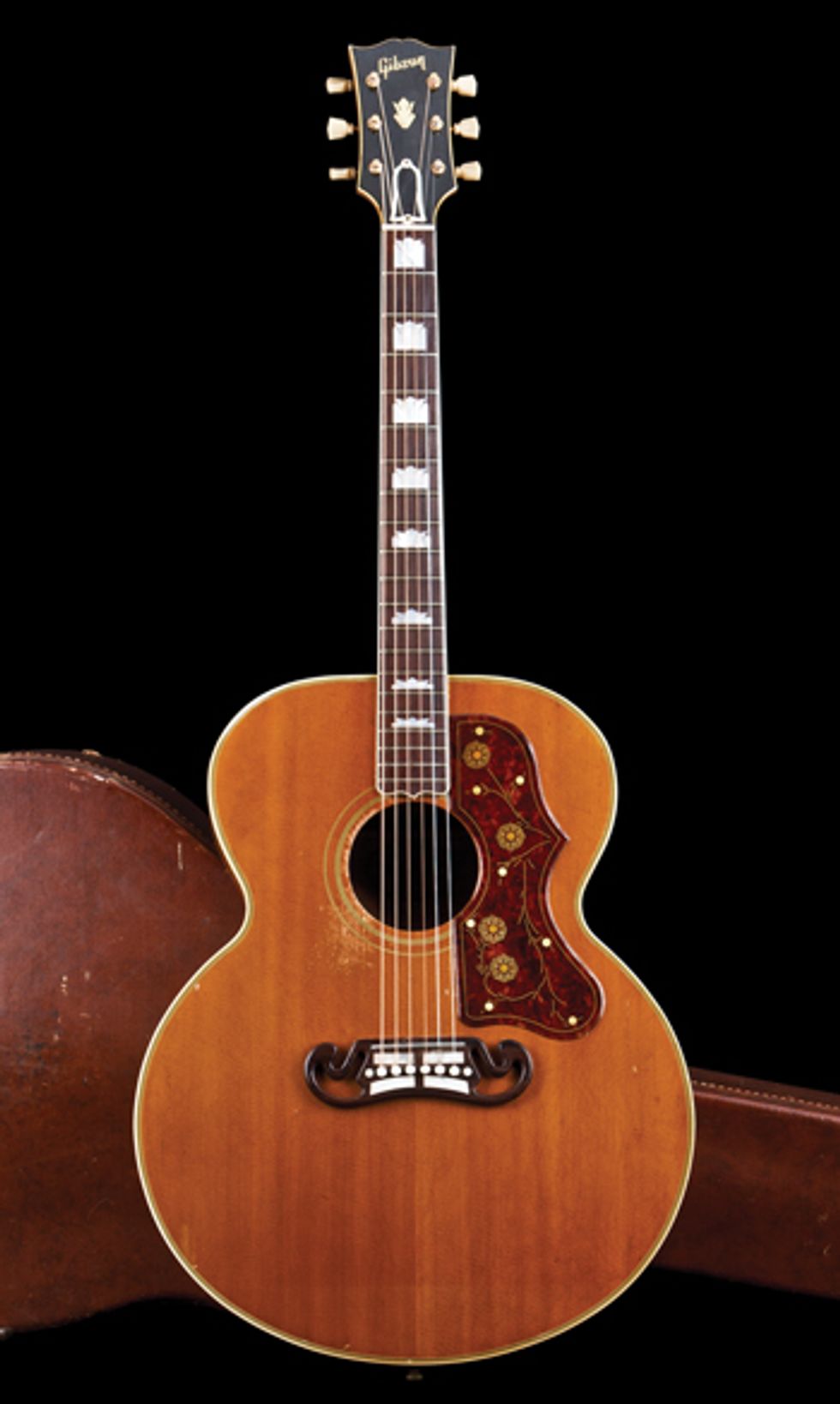
Serial number A20043— a stately 1955 Gibson J-200 in natural finish.
The “singing cowboy” phenomenon of the 1930s was the main inspiration for the “king of the flattops”—Gibson’s J-200. Cowboy movie idol Ray Whitley approached Gibson in 1937 about having a guitar designed to outdo rival Western crooner Gene Autry and his fancy motherof- pearl adorned Martin D-45. The result was the prototype for the Super Jumbo (soon to be called SJ-200 due to its original $200 price).
The original Super Jumbos shared dimensions with Gibson’s 17"-wide L-5 archtop (the very earliest Super Jumbos were 16 7/8" wide). But unlike the L-5, with its maple back and sides, the original SJ-200 came standard with rosewood back and sides. Interestingly, two pre-war SJ-200s with maple back and sides are known to exist.
The guitar featured this month is one of 41 natural-finished J-200s made in 1955 (the “S” had been dropped from the name by this time). This beautifully aged instrument has the characteristics typical of other J-200s from early 1955. It has the distinctive rosewood “moustache” bridge (changed from the original ebony in 1941), a rosewood fretboard with “cloud” inlays (also changed from ebony in 1941), and a two-piece maple neck with a rosewood center strip. The top is spruce, while the back and sides are maple (this was changed from the original rosewood spec after 1946). This guitar’s elaborately engraved flower-andvine pickguard still has the stripe along its border, which disappeared from later versions by the middle of ’55.
According to the 1959 Gibson price list (the closest to ’55 in our archives), a new J-200N listed for $385. A brown Lifton hardshell case would have been an additional $52.50. The current value for a 1955 J-200N in excellent, all-original condition is $12,500.
1. The elaborately engraved
pickguard still has
the stripe along its border,
which disappeared from
later versions. 2. Though
the original J-200s had
rosewood back and sides,
the spec changed to maple
in 1946. 3. Our featured
J-200 was built in Gibson’s
Kalamazoo, Michigan,
factory—the home of so
many classic acoustic and
electric models.
You’ll find a detailed history of J-200s and other Gibson acoustics in Gibson’s Fabulous Flat-Top Guitars by Eldon Whitford, David Vinopal, and Dan Erlewine; Gibson Guitars: 100 Years of an American Icon by Walter Carter; and The Acoustic Guitar by Nick Freeth and Charles Alexander.
Those interested in singing cowboys should check out Douglas B. Green’s article in This Old Guitar: Making Music and Memories from Country to Jazz, Blues to Rock, edited by Margret Aldrich and Michael Dregni. Information on Gibson production can be found in Gibson Shipment Totals 1937-1979 by Larry Meiners.
Original price: $385 in 1959,
plus $52.50 for hardshell case
Current estimated market value: $12,500
Dave Rogers’ collection is tended by Laun Braithwaite and Tim Mullally and is on display at:
Dave’s Guitar Shop
1227 Third Street South
La Crosse, WI 54601
davesguitar.com
Photos by Mullally and text by Braithwaite.
